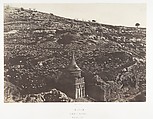Jérusalem, Vallée de Josaphat, Faces Ouest et Nord, 1
Auguste Salzmann French
Printer Imprimerie photographique de Blanquart-Évrard, à Lille French
Not on view
Many viewers who encountered the Valley of Jehoshaphat series in the 1850s immediately recognized the subject as the site of the Last Judgment, the sorting of earthly souls into heaven or hell. Salzmann presents the barren, rock-strewn valley, located eleven miles from Jerusalem, as a rolling landscape that dominates the picture frame. He also documents three saints’ tombs in the valley.
The photographs allowed Salzmann’s viewers not only to see a biblical site but also to visualize a catastrophic yet holy event still to come. The critic and archaeologist Ernest Feydeau (1821–1873) did just that: "The sun straight above, perpendicular, strikes this world of tombs, bursting and buckling beneath the dreadful white rays. Well! What is more terrible in this specter of the valley, what makes you clutch your jumping heart, is that we know that beneath all these stones rots an army of corpses . . . come from the four corners of the world to die in Jerusalem and deposit their bones in the Valley of Judgment." With their fidelity to reality and religious associations, Salzmann’s photographs served as faithful documents of the Holy Land—for him and for his public.
Due to rights restrictions, this image cannot be enlarged, viewed at full screen, or downloaded.

